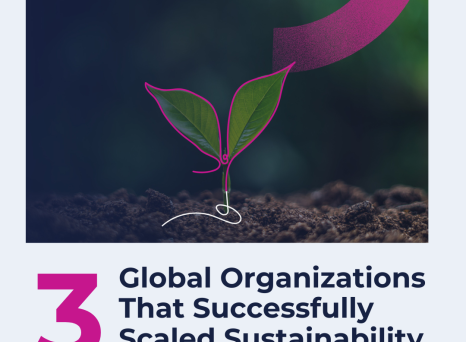IT leaders play a critical role in environmental, social, and governance (ESG) performance. Their access to and knowledge of an organization’s infrastructure and databases makes them gatekeepers of ESG data.
IT leaders play a critical role in environmental, social, and governance (ESG) performance. Their access to and knowledge of an organization’s infrastructure and databases makes them gatekeepers of ESG data. What’s more, IT assets are a significant contributor to an organization’s ESG impact. New research suggests that they could be responsible for up to 3.9% of global greenhouse gas (GHG) emissions. And that’s before you consider other IT-related ESG risks such as precious metal mining, e-waste, and cybersecurity.
To mitigate or reduce IT’s ESG effects, you need accurate, relevant, and real-time data. IT operations can use this data to:
- minimize their supply chain risk
- make their IT assets last longer
- reduce their impact on the environment
- improve brand perception
So, how can IT leaders approach their ESG evaluations to reap these rewards? The answer lies in tried and tested ESG reporting standards and powerful software solutions.
ESG Reporting Standards
The Thompson Reuters Institute found that 71% of C-suite and functional leaders involved in ESG think that its role in corporate performance will continue to grow. Despite its importance, ESG evaluation and reporting remains a confusing landscape of varying measurement frameworks.
Upcoming ESG regulations from the EU and US will clarify the metrics that companies have to report. They’ll also tighten up requirements for ESG rating companies. But, ESG performance is having a tangible impact on businesses as we speak. So, it’s important to start the process of optimizing ESG evaluations now.
Here are 3 reporting standards to consider:
Carbon Disclosure Project (CDP)
The CDP reporting standard was created by and for investors, purchasers, and city stakeholders who want to see an organization’s environmental impact data. It’s a voluntary submission that helps companies, cities, states, and regions measure and manage their environmental risks and opportunities. To do so, the CDP asks organizations to share data on the actions they’ve taken to minimize their operations’ effects on climate change, water security, and deforestation.
Sustainability Accounting Standards Board (SASB)
Sustainability accounting looks at the financial impact that ESG risks have on an organization. So, SASB standards focus on the financial sustainability of an organization when those risks are taken into account. SASB encourages a wider reporting remit which includes all ESG pillars, not just environmental factors. It also has industry-specific standards that span every sector from consumer goods to transportation.
Global Reporting Initiative (GRI)
Established at a UN General Assembly in 1997, the GRI standards are the most widely used ESG reporting standards in the world. They include universal standards and topic-specific standards (such as waste, health and safety, and tax). The GRI is also developing sector-specific standards. It’s starting with industries that have the highest ESG impact, including oil and gas, agriculture, and fishing. GRI standards are often those referenced or required by governments in their ESG policies.
Another aspect that sets the GRI standards apart from others is the intention to meet the needs of multiple stakeholders when reporting ESG performance. This includes investors, executives, employees, customers, and the public.
Applying ESG Reporting Standards in IT Project Management
Familiarizing yourself with different ESG reporting standards is good preparation for any functional leader. But, it’s not always clear how these standards apply to specific functions, such as IT. We’ll explore this next, following the typical phases of an IT project and referencing the widely used GRI reporting standards.
Initiation
During project initiation, you need to answer the central question, “Why is this project needed?” This is the first opportunity to identify project ideas that duplicate existing work or won’t deliver a return on investment. Unnecessary IT projects can negatively impact ESG metrics across multiple GRI topic standards.
Let’s say a stakeholder requests the migration of company data to a new cloud service. Existing cloud infrastructure might already meet the organization’s needs. This could include adequate storage, security, and performance. With the right questions or interrogation of the project idea, you can prevent or minimize wasted development time, which reduces energy consumption and server emissions.
Digital transformation projects like edge computing or cloud computing can have a positive effect on ESG metrics. Greater visibility of your projects and organizational goals in a powerful PPM tool can speed up the project idea evaluation process.
Planning
Elevating your ESG evaluation in this phase doesn’t require extra steps. Instead, it’s a mindset shift to think about more sustainable approaches or swaps in your usual project planning:
- Setting goals. Clear direction is vital for successful IT projects, whether you’re using Agile, Waterfall, or a hybrid project management approach. Specific goals also keep teams focused and avoid wasted energy, materials, and emissions on irrelevant work. This is also the stage where you can incorporate the GRI topic standards for procurement practices and materials. This involves prioritizing local suppliers and recycled materials or components wherever possible, as demonstrated by companies like Quadpack.
- Creating budgets. It’s important to review potential supplier costs with ESG performance in mind. For example, you might choose suppliers that use sustainable materials and green energy. This aligns with your organization’s sustainability goals. But, it can also lead to long-term cost savings through increased efficiency and reduced waste. After one or two projects, you’ll have the data to create a budget for ESG by calculating the cost difference between normal suppliers and suppliers with sustainable practices. These suppliers are also in a position to share ESG data that supports supplier social assessments and supplier environmental assessments for GRI standards.
- Assessing risks. Project risk assessment often takes a short-term view that focuses on process and relationship-related risks. Common project risks you might factor into planning include deliverable definition, resource conflicts, and stakeholder approvals. But, you’ll need to think longer-term and outside your organization for ESG risks. The economic performance GRI topic standard, for example, seeks to understand the impact that aspects of climate change will have on your operations. It also asks what steps you’re taking to manage the risk. You can incorporate this standard on a project level. Do this by considering how you can lessen environmental impact through more energy-efficient processes and clean-energy suppliers.
Execution
As you and your team set deliverables and milestones, it’s important to keep social and governance factors front of mind. To help you do so, we’d recommend reading and sharing some of GRI’s key resources:
- A Short Introduction to the GRI Standards. A helpful primer for understanding the GRI standards and the reporting process.
- GRI 1: Foundation. This explains the purpose of the GRI reporting standards, key concepts for new users, and how to apply the reporting principles.
- GR 2: General Disclosures. This details the disclosures (data submissions) that GRI requires from every organization to meet its sustainability reporting standards. They include details about an organization’s structure, reporting practices, activities, workers, governance, and policies. This helps ground topic-specific disclosures in the context of an organization’s profile and scale.
- GRI 3: Material topics. This explains the steps an organization can take to identify its material topics—the sustainability topics that its operations are most likely to impact. It also details how to report its material topics, as well as its process to determine them and how it manages each of them.
Monitor and Control
There are two key benefits to measuring your ESG performance alongside time, cost, scope, quality, and risk during your IT project:
- Embedding the importance of ESG performance. By adding ESG factors to the key performance indicators (KPIs) of your project, you show your teams that they’re part of the project’s success. Demonstrating clear links between a project’s ESG metrics and organizational goals will further emphasize their importance. But, it’s important to note that metrics alone won’t be enough to create a culture that prioritizes ESG factors. This requires consistent communication, training, and a reward system that recognizes contributions to ESG performance.
- Identifying links between ESG and other metrics. When you track ESG alongside your other project metrics, you can see the effects one has on the other. Let’s say your project includes an initiative to reduce energy consumption by installing energy-efficient systems. You might see a direct reduction in operational costs in your budget. By including ESG measures for this project, you’ll be able to report the energy savings and their positive environmental impact, as well as the cost savings. These are valuable insights that help demonstrate the value of ESG evaluation to employees and stakeholders.
When you have more to measure, it’s important to ensure your tools are up to the task. Look for PPM software that can:
- Centralize your project data, including ESG metrics
- Create clear, compelling views of your project performance for multiple stakeholders
- Automate your analytics so that you can maintain focus on project delivery and ESG performance
Reviewing your IT project’s performance is the final step in enhancing your ESG evaluation. Whether you use Lessons Learned or retrospectives, make ESG a focus of your project reviews for the whole team. They may have identified successes or challenges that aren’t captured by your project dashboards. This adds valuable context to your data-driven project reports.
Preparing for, rather than reacting to, ESG-related legislation will put you in a stronger position with regulators and customers. If you take steps now to understand ESG reporting standards and embed ESG evaluation throughout your IT project management, you’ll be future-proofing your function.


